
💸 Earn Instantly With This Task
No fees, no waiting — your earnings could be 1 click away.

💸 Earn Instantly With This Task
No fees, no waiting — your earnings could be 1 click away.
Start Earning
Vintage clothing is in. More and more people are buying it, therefore it’s easier than ever to make money from selling retro fashion. It’s official: second-hand is sexy!
Endorsement from fashion icons, such as supermodel Kate Moss and stylist Bay Garnett, has helped charity shop fashion take hold on the high street. That’s great news if you love fashion and would like to pick up some extra money finding vintage clothing.
Cash in on this sudden wave of thrift shop chic by rifling through the back of your wardrobe, trudging down to your local charity shop and looking out for hidden gems wherever you go. Then all you have to do is find the right buyer to make a tidy profit!
- What to look for in vintage clothing
- Where to look for vintage clothing
- Where to sell vintage clothing
What is Vintage Clothing?
It’s perhaps slightly depressing, but ‘vintage’ means anything older than about twenty years, when it comes to clothes. So, if you still have a Pierce the Veil original t-shirt from 2005, it might sell for a small fortune.
Items that always sell well when it comes to vintage are:
- Band t-shirts
- Leather jackets
- Coats of all kinds
- Distinctive fashionable shapes, like bell bottoms
- Designer labels
- Accessories like costume jewellery, sunglasses, and handbags
But as long as something is in great condition, you could get a pretty penny for it. Once you’ve rummaged through your own wardrobe, it’s time to expand your horizons and check out thrift shops for some bargains to flip for extra cash.
Step 1: What to look for in vintage clothing
Everyone is always looking for great bargains. If you want to make profit from vintage clothing, regularly check your local vintage wear goldmine to see if any new stock has come in that could potentially make you a mint. It’ll require a little patience and a lot of rummaging, but it might just pay off!
Have a rummage
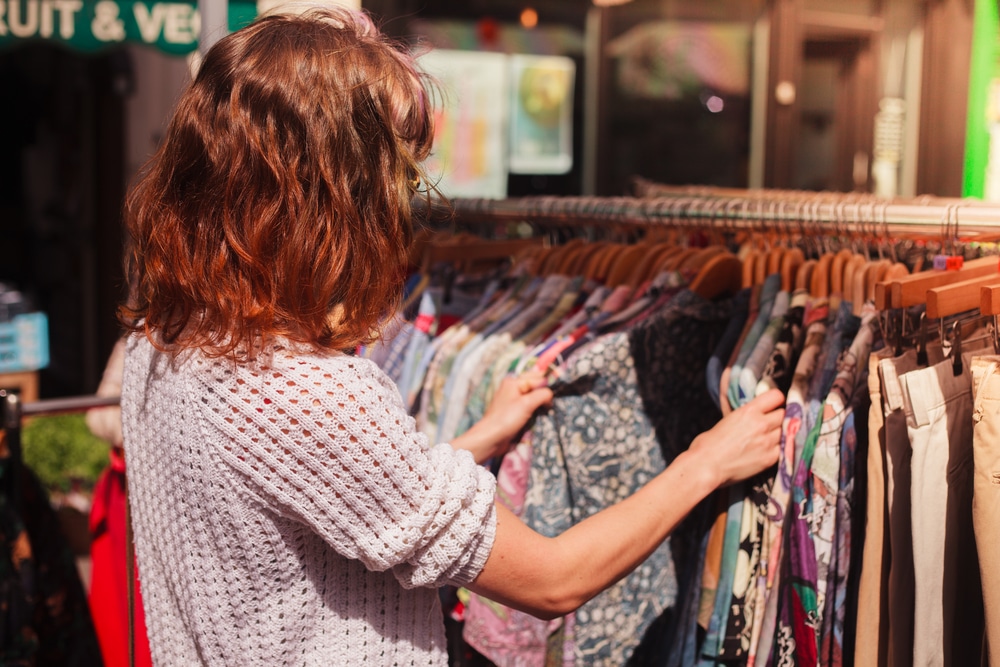
The number one rule when visiting charity shops is: don’t be afraid to rummage. The most collectable items tend to lurk at the bottom of the pile so roll up your sleeves and get to work.
Another important thing to remember is to keep going back to any shop you think might have hidden treasures. The good stuff goes fast and popping to the store twice a week is not excessive for an enthusiastic collector. You might even want to check with the shop assistant to find out when they get deliveries so you’re there when new stock arrives.
Choose the right material
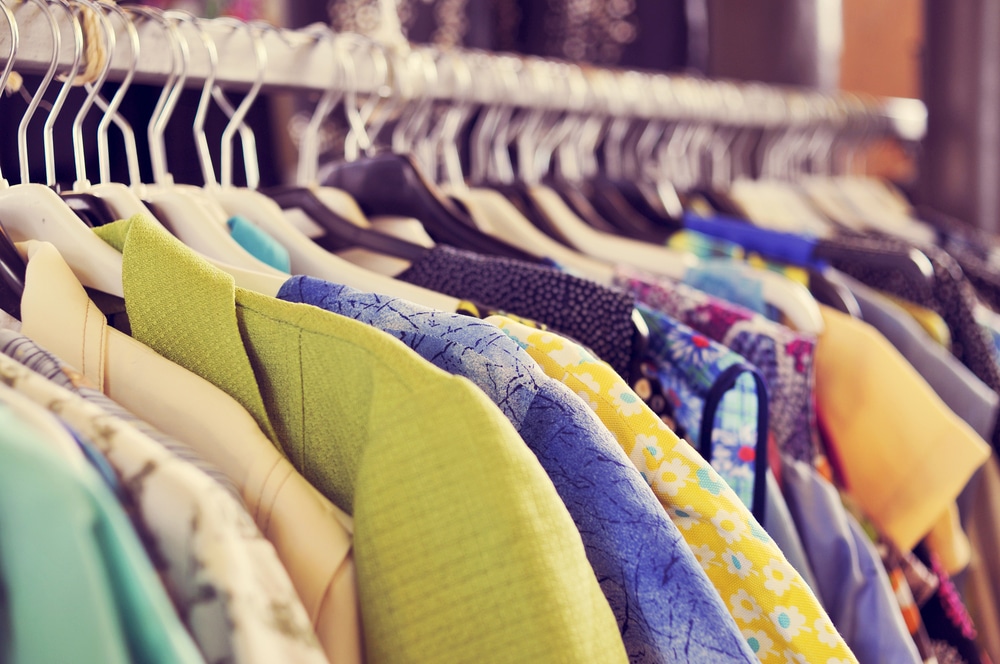
Don’t just buy anything. There’re certain fabrics that’ll be easier to sell.
Lena Weber, editor of vintage fashion tribute website QueensofVintage and self-confessed vintage clothing addict, says:
“Definitely avoid very artificial fabrics as they are a nightmare to keep clean. Ideally look for items that are made of high quality fabrics such as wool or cotton. I wouldn’t be too worried if an item has a small hole, is missing a button or needs to be hemmed up, this can all be easily fixed. You can find tips on how to remodel ill-fitting vintage in a few quick steps on QueensofVintage.”
Don’t overspend

There aren’t any items of clothing in particular that make the most profit. It all depends on how much you paid for it, the condition of the item, what label it carries and how limited its availability is. It might take a little research to get a good idea of what certain pieces of clothing are worth.
If you’re just starting out, try not to pay more than £20-£30 for any one item. But, with a bit of knowledge and a dollop of good luck, finding a pair of £5 vintage shoes in a charity shop and selling them on for £40-£50 is definitely doable.
Step 2: Where to look for vintage clothing
Before you go trawling through every thrift store in town, look a little closer to home. Most of us have bags of clothes in our attics and wardrobes just waiting to come back into style. Those baggy ‘mum jeans’ you chucked when skinny trousers became all the rage? Dig them out – they’re back in and selling like hot cakes!
Cash in the attic
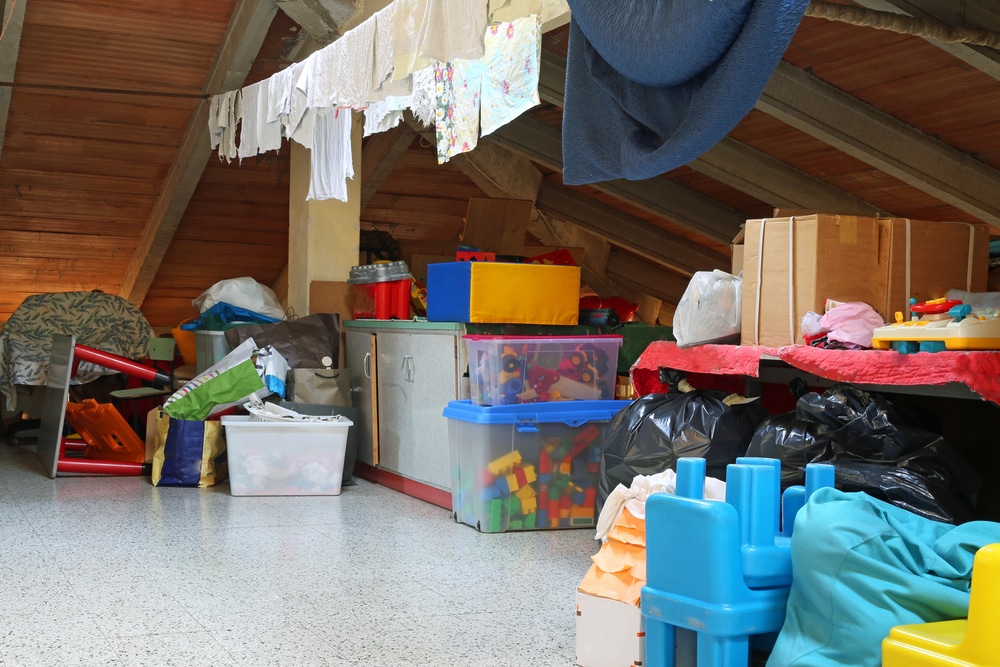
Have a look through. Perhaps you already have something in good condition that might make you a profit.
Remember, even if you think an item is absolutely hideous, it might well be in fashion right now. Or – with a little creativity and a pair of sharp scissors – you can make it fashionable. Upcycled clothes can fetch more than the original, when done well!
Keep an open mind about styles, colours and fabrics. Unless you’re already an expert, you can never be too sure if you’ve come across the holy grail of stilettos.
Swap it

Try having a swap shop with friends (or strangers) to see if you can pick anything out from their junk that could be worth something.
Check out Swishing.com and Eventbrite to find your nearest clothes swap party, or set up your own and create an invite on Facebook local groups to turn it into a big event.
Hit the high street
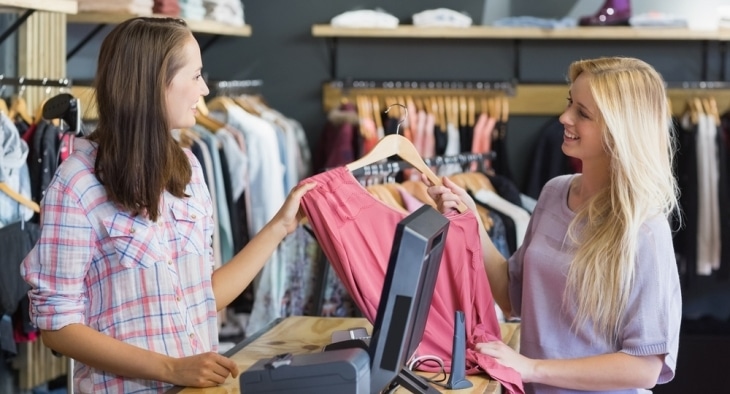
After you’ve turned your house upside down and hassled all your friends, try looking a little further away from home. Most high streets have a charity shop or two. Those are ideal for finding forgotten garments handed down through generations. The trick is to inspect everything you find and then trust your instincts.
If you fall in love with an item at first glance – unless you’ve got a particularly quirky style – chances are someone else might too.
Although big names generally sell for more money, it’s much more difficult to find them for just a few quid. To begin with, stick to lower-priced items.
Vintage clothing stores are also a great place to find some original and quirky pieces. The only trouble is you’re a lot less likely to make any profit on items you find there. Why? The shop owners are generally experts in their field. They’ll know which items are more valuable and can therefore be taken to auction or sold for more.
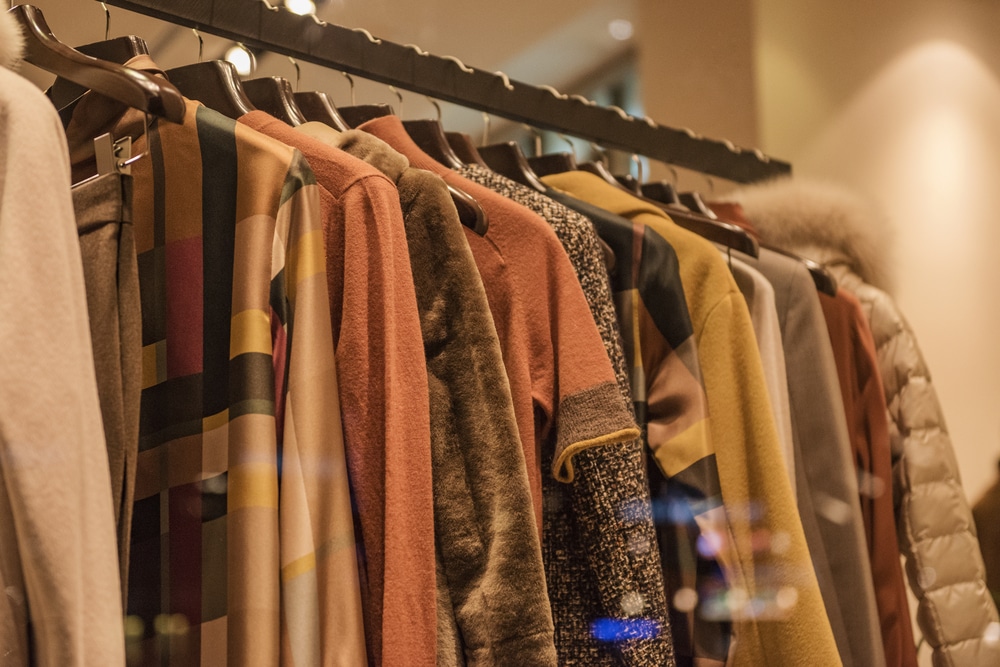
Having said that, shops offering vintage clothing are often willing to haggle, so give it a go. It’s certainly worth having a look every now and again. You never know what might be hiding beneath a pile of polka dot dresses.
Lena says: “Charity shops are a great place for vintage bargains. The same goes for large vintage shops in non-trendy areas; stay away from Camden Market or Brick Lane, for example. There are also some fantastic online shops such as somelikeitvintage that have amazing bargain items.“
Right now, originality is the key to being stylish. Buying vintage clothing pretty much guarantees that you’re not going to turn up to a party wearing the same dress as someone else.
Popular celebs like Alexa Chung swear by vintage. This has given the market for second-hand clothing a serious boost and for you – a great way to earn some extra cash.
Find out how to make money collecting vintage shoes.
Step 3: Who to sell your vintage clothing to
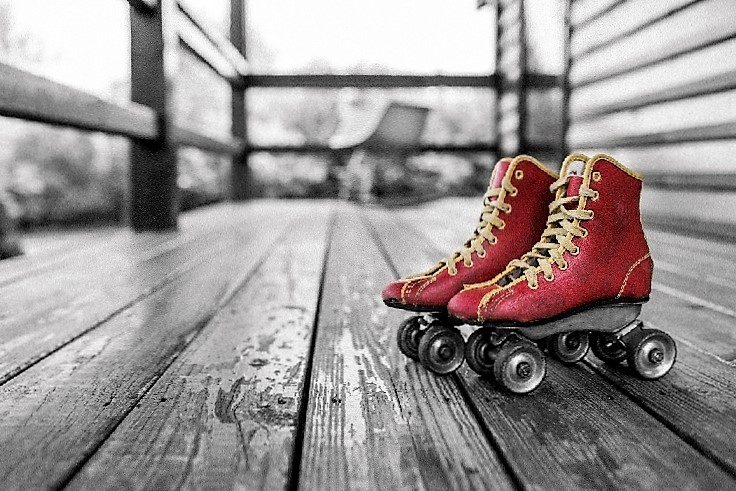
There’re literally thousands of collectors out there searching for certain items. If you stumble upon a true gem, selling won’t be a problem. Those into fashion are willing to pay big bucks for the much-coveted vintage designer shoe, for instance.
Memorable footwear also does very well in auction. The famous ruby-red slippers worn by Judy Garland in The Wizard of Oz made $666,000 (then around £412,000) when sold at auction in 2000.
Just remember that the chances of you stumbling upon a moneymaker like that are one in a million!
There’re a few different places you can sell your newly-purchased vintage clothing and footwear.
NEVER MISS A NEW MONEY-MAKING IDEA: SIGN UP TO OUR WEEKLY NEWSLETTER HERE
eBay

Of course, the first place you may think of is eBay. And yes, people often make a tidy sum from buying and selling there.
However, collectors and fashion addicts are getting wise to the scammers and time wasters populating eBay and often seek alternatives. It’s something worth thinking about. If you do choose to sell with eBay, there’s a few things to remember.
Put in a bit of extra time when you list an item and it’ll pay off. A good rule of thumb is to describe the things you’re selling as if there weren’t any photos available. Specify the type of fabric, explain the garment care instructions and always include the measurements as sizes vary depending on the era and country. For example, a vintage size 14 dress may be closer to a modern size 10. List the age, original retail price and place of initial purchase if you know it. Don’t forget to mention any damage such as stains, tears or missing buttons.
A picture really is worth a thousand words, so always include good quality, well-lit photos with your listing. On eBay, you can post up to 12 pictures – make each one count. If you own a mannequin, use it to display the item. Opt for a white background and ensure you show any damage.
eBay listings are free, so make sure you take advantage of this. To boost visibility or include your item in multiple categories, you’ll need to pay small fees.
Take a look at these 20 handy tips to make money on eBay today.
ETSY

Etsy is another good place to flog your fashion finds – and particularly vintage clothing. The great thing about it is that it’s not limited to clothes only. You can also sell vintage prints and artwork.
Judging from the site, you might get the impression that this business is primarily in the United States, but don’t let that put you off. A third of sales comes from international buyers.
And the number of those is staggering. There’re 39.4 million active buyers on Etsy, and only 2.1 million sellers. That means there’re more than enough customers to go around.
Getting started as a seller on Etsy is easy – the first thing to do is register for a buyer account. Be careful when choosing your username as it’ll also pop up as your shop name. It’ll show up as .
Take a few minutes and read the marketplace’s Beginner’s Guide to ensure that you get off on the right foot.
Just like any other website where you sell vintage clothing, images are key. Having good quality photos is crucial to sell successfully on Etsy. You’re allowed five pics per item, which isn’t much, so make sure they’re truly showing off the item you’re trading. You can hone your snapping skills with the site’s useful guide to perfecting your product photography.
Vinted
Vinted is a platform specifically for pre-loved or second-hand clothes and accessories. Be prepared for people haggling! Set your prices a little higher than you’re prepared to let items go for, as people expect to negotiate on this app.
There are no fees or commission to pay with Vinted; they make their money through the Buyer Protection Fee which the buyer pays.
Make sure you list everything as accurately as possible. Clothes displayed on a mannequin sell better than items laid flat, and it’s important to list the actual tape measurements of bust, hips, chest, etc rather than the label size as sizing can vary so much between shops – especially vintage items.
SOCIAL NETWORKS

Facebook selling groups are giving eBay a run for its money as the best place to earn cash by selling second-hand items. Why? It’s free. Most people use Facebook every day and it’s easy to post an item to sell between updating your status and checking out what your friends have been up to. You can find selling groups across the country with thousands of members keen to buy anything vintage. Simply search for “UK vintage selling groups”. Offering items for sale is just as simple – all you need do is post directly on your group’s page and upload a photograph.
It’s worth putting a clear deadline in your ad, along the lines of ‘will offer to the next person down if collection time not agreed within 24 hours’.
If you’ve done a really big clear-out and have lots to offload, list as many goods as possible in one batch. Pick a day when you’re online, so you can answer questions promptly and don’t lose sales. This way, you can also arrange one or two time slots for collections.
Remember, groups are public. Keep personal details off posts and only accept payments via PayPal.

It’s also worth looking at Instagram. Set up an account and find like-minded followers by searching hashtags such as #vintagesellingpage and #vintagesale. Since it’s a photo-centric social media app, it’s key you have stunning photos of your vintage clothing.
Remember to always hold the sale under a separate account from your personal one. Otherwise, you’ll be spamming your friends and family rather than reaching prospective buyers. Create an account and post all the photos of your items with their descriptions before you start the sale. That way you can focus on making deals rather than uploading pictures.
With this type of sale, you need to be organised. Keep a record – perhaps a spreadsheet – with the details of the sold price, any postage costs charged to the buyer and shipping information. Having all the information in one place means you can easily keep track of where to ship items and when payments come through.
Just before you start the sale, always post a list of “sale rules”. This will cut down the number of complaints or issues that pop up later. You should include information such as start/end time of the sale, how to make bids (bid amount with PayPal email is often easiest) and list any postage restrictions (UK only, for instance). It’s worth stipulating that payments must be received within 24 hours of receiving the PayPal money request. You should clarify that if the buyer fails to comply, they’ll lose their item and it’ll go to the next highest bid.
Specialist sites and auctions

If you’ve got your heart set on auctioning your goods off, try SpecialistAuctions. The site has a specific section dedicated to vintage wear.
You can also check out local auction houses to see if they have any vintage clothing auctions running in the near future. If they don’t, it probably isn’t worth your time.
A good way to reach thousands among your target market is by displaying your goods on a specialist website. Meanwhile, a real life auction without your specific audience will attract a couple of bidders at the most.
If you’ve picked up anything particularly classy on your travels, send an email to dawn@candysays.co.uk (from the website CandySays) describing your items. Include some pictures if possible and she’ll let you know whether or not she wants it for her online store and for what price.
Of course, to get an idea of value for your items, you could haul them along to your local vintage store and just ask them for advice.
You never know, they might even offer you a nice wad of cash for what you’ve got.

Selling clothes for a living may sound cool and easy but to make a solid profit, you’ll need to invest some time into it. Making a full-time living by buying and selling vintage clothing and shoes isn’t something you should think about unless you’re an expert in the field.
If it’s a way to make some extra cash, you can definitely expect to earn a few quid by buying an item for a couple of pounds and selling it on for a double figure.
You could make big money by buying designer wear and big names as an investment. Labels like Chanel, Givenchy and Dior, for example, will only increase in value as time goes by – if items are in good condition. But you can go smaller buying less prestigious brands and make vintage clothing simply an additional source of income without the commitment of relying on it full time.
NEVER MISS A NEW MONEY-MAKING IDEA: SIGN UP TO OUR WEEKLY NEWSLETTER HERE
The post Make Money from Vintage Clothing appeared first on MoneyMagpie.

💸 Earn Instantly With This Task
No fees, no waiting — your earnings could be 1 click away.
Start Earning
















